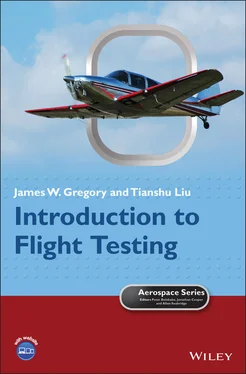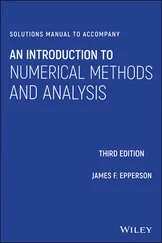In the United States, the regulatory authority for the FAA to certify the airworthiness of light aircraft is Title 14 of the Code of Federal Regulations (“Aeronautics and Space”), Chapter I (“Federal Aviation Administration, Department of Transportation”), Subchapter C (“Aircraft”), Part 23 (“Airworthiness Standards: Normal Category Airplanes”) – we'll refer to this as 14 CFR §23 or simply part 23 (U.S. Code of Federal Regulations 2021). Part 23 covers the certification standards for general aviation aircraft, which have a maximum takeoff weight of 19,000 lb or less and carry 19 or fewer passengers. Since the scope of this book focuses on light aircraft, Part 23 is most relevant for our purposes. The subpart that is most relevant for flight testing is Subpart B (14 CFR §23.2100 through §23.2165), which defines the requirements for flight testing of aircraft for airworthiness certification.
Aircraft certified under Part 23 are grouped into different certification and performance levels based on number of passengers that can be carried and flight speed (14 CFR §23.2005), which are summarized in Table 1.1. Each level indicates a higher hazard, and a correspondingly higher bar is set to mitigate the risks associated with those hazards. Aircraft at the higher certification levels and higher performance levels will have higher standards to meet for certification.
Part 23 details the standards of safe flight that must be met for an aircraft to be certified as airworthy by the FAA, organized into broad categories of performance metrics and flight characteristics. Performance metrics include defining limits on the aircraft weight and center of gravity position, the stall speed of the aircraft under various operating conditions, takeoff performance, climb performance, glide performance, and landing distance required. The flight characteristics for certification include demonstration that the airplane is controllable and maneuverable; that the airplane can be trimmed in flight; that it has static and dynamic longitudinal, lateral, and directional stability; that the aircraft has controllable stall characteristics in all maneuvers and that sufficient stall warning is provided; that spins are recoverable; that the airplane has controllable ground handling characteristics; and that vibration and buffeting do not interfere with control of the airplane or cause excessive fatigue. If certification is requested for flight into known icing conditions, then the aircraft performance and handling characteristics must be shown to the same level of safety even in icing conditions. This textbook provides an introduction to the underlying principles for some of these flight tests; more detailed information is available from Kimberlin (2003) or FAA Advisory Circulars (2003, 2011).
Table 1.1 Airworthiness certification levels defined by part 23.
Source: Based on FAA (2011).
| Airplane certification levels |
Airplane performance levels |
| Level 1 |
Maximum seating configuration of 0–1 passengers |
Low speed |
Airplanes with a V NOand V MO≤ 250 KCAS (and M MO≤ 0.6) |
| Level 2 |
Maximum seating configuration of 2–6 passengers |
| Level 3 |
Maximum seating configuration of 7–9 passengers |
High speed |
Airplanes with a V NOor V MO> 250 KCAS (and M MO> 0.6) |
| Level 4 |
Maximum seating configuration of 10–19 passengers |
V NO= maximum structural cruising speed, V MO= maximum operating limit speed, M MO= maximum operating Mach number, and KCAS represents the units for knots calibrated airspeed.
While the regulatory framework and overall safety criteria are defined in Part 23, the regulations are intentionally sparse on details on how to actually demonstrate compliance for certification. Instead, means of compliance (§23.2010) can be determined by the applicant, subject to approval by the FAA. Typically, the means of compliance is established by a consensus standard. A type certificate applicant for a new light aircraft could demonstrate compliance with a consensus‐based industry standard, which has been approved by the FAA. This compliance mechanism is a dynamic and flexible approach (compared to explicitly defining the compliance mechanisms in part 23), since consensus‐forming bodies can quickly respond to new technologies and develop consensus standards. One key example of such a body is ASTM International. The ASTM convenes a number of committees, which are populated by representatives from various industry groups, and also includes government (FAA) representatives. The key ASTM committee that covers certification standards for light aircraft is the F44 committee on General Aviation Aircraft and specifically the F44.20 subcommittee on Flight. At the time of writing this book, ASTM F44.20 had published standard specifications for flight test demonstration of aircraft weight and center of gravity, operating limitations, aircraft handling characteristics, performance, and low‐speed flight characteristics (ASTM 2017, 2018a, 2018b, 2019a, 2019b). Historical guidance from the FAA is also available for means of compliance with 14 CFR part 23 through nonregulatory advisory circulars (FAA 2003, 2011).
It's important to also be familiar with the historical approaches to airworthiness certification, since there are many aircraft flying today that were certified under older versions of the regulations. Predating certification of general aviation aircraft under part 23, certification was granted under the Civil Air Regulations (from the late 1930s until 1965). Kimberlin (2003, chapter 1) provides a good synopsis of these older regulations and how antique aircraft are still flying under airworthiness certificates granted under the older regulations.
For decades, certification of light general aviation aircraft followed regimented flight testing protocols that were explicitly defined in part 23. Over the years, the part grew more complex as additional safety measures and compliance protocols were codified. The resulting regulation was a rigid document that could not easily accommodate new technologies. For example, part 23 was strictly written to document how a type applicant must demonstrate the performance of internal combustion engines and the associated fuel system. This strict delineation of a compliance pathway was fine when all general aviation aircraft were powered by internal combustion engines running off Avgas. However, there are new propulsion system concepts emerging such as electric motors driven by fuel cells, batteries, or hybrid battery‐generator systems, but these could not be certified under the former regimented structure of part 23. Type certificate applicants would have had to demonstrate an equivalent level of safety and obtain waivers, but there was no established and agreed‐upon process for doing so. Thus, certification of new technologies such as electric propulsion would have been costly, with an uncertain outcome.
The current certification framework was developed in response to these challenges, leading to a complete rewrite of part 23 in 2016. With the rewrite of part 23, the FAA removed historical designations of various certification categories for airplanes. While these categories no longer exist for new aircraft certifications, any aircraft certified under the old part 23 will retain its category designation. These categories are normal, utility, acrobatic, and commuter. The commuter category is the designation for the largest general aviation aircraft, with a maximum takeoff weight of 19,000 lb, a passenger seating capacity of up to 19, and multiple engines. The normal, utility, and acrobatic categories all have a much lower weight limit of 12,500 lb and a seating capacity of up to 9. Normal category airplanes are approved for normal (routine) flying, stalls (but not “whip stalls”), and routine commercial maneuvers (less than 60° bank). Airplanes certified for utility category are approved for limited aerobatic maneuvers, which may include spins and commercial maneuvers at higher bank angles (up to 90°). Acrobatic category airplanes are approved for acrobatic maneuvers, which is basically any maneuver that a pilot can fly, and found to be safe in the flight testing program. For the normal, utility, and acrobatic categories, a given airplane could be certified for one, two, or all three, with varying operating limitations corresponding to each. Given that there are many aircraft routinely flying today that are well over 60 years old, one can anticipate that these legacy certification categories will persist for quite some time as historical and current aircraft continue flying.
Читать дальше












